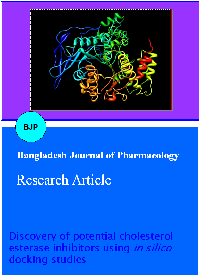Discovery of potential cholesterol esterase inhibitors using in silico docking studies
DOI:
https://doi.org/10.3329/bjp.v8i3.14521Keywords:
Cholesterol Esterase, Flavonoids, Binding energy, Inhibition constant, Dockingstudies, AutoDock ToolsAbstract
New drug discovery is considered broadly in terms of two kinds of investigational activities such as exploration and exploitation. This study deals with the evaluation of the cholesterol esterase inhibitory activity of flavonoids apigenin, biochanin, curcumin, diosmetin, epipervilline, glycitein, okanin, rhamnazin and tangeritin using in silico docking studies. In silico docking studies were carried out using AutoDock 4.2, based on the Lamarckian genetic algorithm principle. The results showed that all the selected flavonoids showed binding energy ranging between -7.08 kcal/mol to -5.64 kcal/mol when compared with that of the standard compound gallic acid (-4.11 kcal/mol). Intermolecular energy (-9.13 kcal/mol to -7.09 kcal/mol) and inhibition constant (6.48 µM to 73.18 µM) of the ligands also coincide with the binding energy. All the selected flavonoids contributed cholesterol esterase inhibitory activity, these molecular docking analyses could lead to the further develop-ment of potent cholesterol esterase inhibitors for the treatment of obesity.
Downloads
504
338 Read
12
References
Androutsopoulos VP, Spandidos DA. The flavonoids diosmetin and luteolin exert synergistic cytostatic effects in human hepatoma HepG2 cells via CYP1A-catalyzed metabolism, activation of JNK and ERK and P53/P21 up-regulation. J Nutr Biochem. 2012; 6: 27.
Barness LA, Opitz JM, Gilbert-Barness E. Obesity: Genetic, molecular, and environmental aspects. Am J Med Genetics Part A. 2007; 143A: 3016-34.
Birari RB, Bhutani KK. Pancreatic lipase inhibitors from natural sources: unexplored potential. Drug Discov Today. 2007; 12: 879-88.
Chang MW, Ayeni C, Breuer S, et al. Virtual screening for HIV protease inhibitors: A comparison of AutoDock 4 and vina. PLoS ONE. 2010; 5: 11955.
Collignon B, Schulz R, Smith JC. Task-parallel message passing interface implementation of Autodock4 for docking of very large databases of compounds using high-performance supercomputers. J Comput Chem. 2011; 32: 1202-09.
Cosconati S, Forli S, Perryman AL, Harris R, Goodsell DS, Olson AJ. Virtual Screening with AutoDock: Theory and practice. Expert Opin Drug Discov. 2010; 5: 597- 607.
Da YC, Jui HS, Laurence T, Shyan SC, Sheng W, TienJC, YaJL, Kun WC, Wei LH. Curcumin inhibits influenza virus infection and haemagglutination activity. Food Chem. 2010; 119: 1346-51.
Datla K, Christidou M, Widmer W, Rooprai H, Dexter D. Tissue distribution and neuroprotective effects of citrus flavonoid tangeretin in a rat model of Parkinson's disease. Neuroreport 2001; 12: 3871-75.
Goodsell DS, Morris GM, Olson AJ. Automated docking of flexible ligands: Applications of Autodock. J Mol Recog. 1996; 9: 1-5.
Harinantenaina L, Brodie PJ, Slebodnick C, Callmander MW, Rakotobe E, Randrianasolo S, Randrianaivo R, Rasamison VE, Tendyke K, Shen Y, Suh EM, Kingston DG. Antiproliferative compounds from Pongamiopsis pervilleana from the Madagascar Dry Forest. J Nat Prod. 2010; 73: 1559-62.
Jin SK, Young S, Yong KC, Nam HK, Hee JJ, Ji WK, Eoh JL, Tae OK, Hun TC, Hyun OP. Okanin, a chalcone found in the genus Bidens, and 3-penten-2-one inhibit inducible nitric oxide synthase expression via heme oxygenase-1 induction in RAW264.7 macrophages activated with lipopolysaccharide. J Clin Biochem Nutr. 2012; 50: 53-58.
John ST,Sakkiah S, Lee KW. Discovery of potential pancreatic cholesterol esterase inhibitors using pharmacophore modelling, virtual screening and optimization studies. J Enzy Inhibi Med Chem. 2010; 1-11.
Khodade P, Prabhu R, Chandra N, et al. Parallel implementation of Autodock. J Applied Crystall. 2007; 40: 598-99.
Koppen H. Virtual screening: What does it give us? Curr Opin Drug Disc Dev. 2009; 12: 397-407.
Martini ND, KaterereDR, Eloff JN. Biological activity of five antibacterial flavonoids from Combretumerythrophyllum(Combretaceae). Pharmazie 2001; 56: 749-50.
Morris G, Goodsell D, Halliday R, et al. Automated docking using Lamarckian genetic algorithm and an empirical binding free energy function. J Comput Chem. 1998; 19: 1639-62.
Morris GM, Huey R, Lindstrom W, et al. AutoDock 4 and AutoDock Tools 4: Automated docking with selective receptor flexibility. J Comput Chem. 2009; 30: 2785-91.
Pande V. Antioxidant activity of rhamnazin-4'-O-beta-[apiosyl(1-->2)] glucoside in the brain of aged rats. J Ethnopharmacol. 2004; 93: 207-12.
Park H, Lee J, Lee S. Critical assessment of the automated AutoDock as a new docking tool for virtual screening. Proteins 2006; 65: 549-54.
Ramgopal M, AttitallaIH, Avinash P, Balaji M. Evaluation of antilipidemic and anti-obesity efficacy of Bauhinia purpurea bark extract on rats fed with high fat diet. Academic J Plant Sci. 2010; 3: 104-07.
Schames JR, Henchman RH, SeigelJS, Sotriffer CA, Ni H, McCammon A. Discovery of a novel binding trench in HIV integrase. J Med Chem. 2004; 47: 1879-81.
Schoichet BK. Virtual screening of chemical libraries. Nature 2004; 43: 862-65.
Umamaheswari M, Madeswaran A, Asokkumar K, Sivashanmugam T, Subhadradevi V, Jagannath P. Discovery of potential xanthine oxidase inhibitors using in silico docking studies. Der Pharma Chemica. 2011; 3: 240-47.
Whittern CC, Miller EE, Pratt DE. Cottonseed flavonoids as lipid antioxidants. J Am Chem Soc. 1984; 61: 1072-75.
Zhang S, Kumar K, Jiang X, et al. DOVIS: An implementation for high throughput virtual screening using Autodock. BMC Bioinformatics. 2008; 9: 126.

Published
How to Cite
Issue
Section
License
Authors who publish with this journal agree to the following terms:
- Authors retain copyright and grant the journal right of first publication with the work simultaneously licensed under a Creative Commons Attribution License that allows others to share the work with an acknowledgement of the work's authorship and initial publication in this journal.
- Authors are able to enter into separate, additional contractual arrangements for the non-exclusive distribution of the journal's published version of the work (e.g., post it to an institutional repository or publish it in a book), with an acknowledgement of its initial publication in this journal.
- Authors are permitted and encouraged to post their work online (e.g., in institutional repositories or on their website) prior to and during the submission process, as it can lead to productive exchanges, as well as earlier and greater citation of published work (See The Effect of Open Access).
